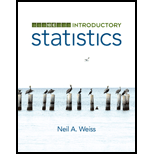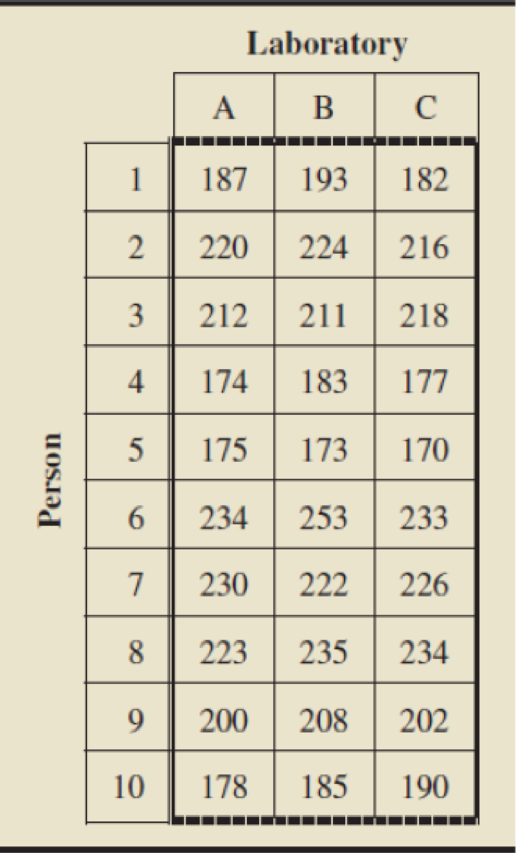
Introductory Statistics (10th Edition)
10th Edition
ISBN: 9780321989178
Author: Neil A. Weiss
Publisher: PEARSON
expand_more
expand_more
format_list_bulleted
Concept explainers
Textbook Question
Chapter C.5, Problem 91E
In each of Exercises C.91–C.97, identify the following:
- a. the treatment factor
- b. the blocking factor
- c. the levels of each factor
- d. the number of treatments
- e. the number of blocks
- f. the experimental units
- g. the experimental factors, if any
- h. the classification factors, if any
- i. the fixed effect factors
- j. the random effect factors, if any
- k. whether the study is a designed experiment or an observational study
C.91 Cholesterol Testing. A large health care organization uses three laboratories for the routine analysis of blood samples. It is important that the three labs provide equivalent test results. To check that, blood samples are obtained from 10 randomly selected individuals; each blood sample is then divided into three blood subsamples of equal volume; and then the three blood subsamples from each person are sent to different labs. For this problem, the analysis is confined to assessing the measurement of the total cholesterol level for a person. The data are in the following table.

Expert Solution & Answer
Want to see the full answer?
Check out a sample textbook solution
Students have asked these similar questions
Show all work
Show all work
Show all work
Chapter C Solutions
Introductory Statistics (10th Edition)
Ch. C.1 - Define the following terms: a. factor b. levels of...Ch. C.1 - A three-way factorial design has Factor A at 3...Ch. C.1 - A four-way factorial design has Factor A at 2...Ch. C.1 - A three-way factorial design has Factor A at 6...Ch. C.1 - Answer true or false to each of the following...Ch. C.1 - Prob. 8ECh. C.1 - Answer true or false to each of the following...Ch. C.1 - Prob. 10ECh. C.1 - In each of Exercises C.11C.17 identify the...Ch. C.1 - In each of Exercises C.11C.17 identify the...
Ch. C.1 - In each of Exercises C.11C.17 identify the...Ch. C.1 - In each of Exercises C.11C.17 identify the...Ch. C.1 - In each of Exercises C.11C.17 identify the...Ch. C.1 - Prob. 16ECh. C.1 - In each of Exercises C.11C.17 identify the...Ch. C.2 - Consider a 3 4 ANOVA. a. Identify the number of...Ch. C.2 - Consider a 4 2 ANOVA. a. Identify the number of...Ch. C.2 - Prob. 25ECh. C.2 - Prob. 26ECh. C.2 - Prob. 27ECh. C.2 - Prob. 28ECh. C.2 - In two-way ANOVA, identify what we mean by a. a...Ch. C.2 - In two-way ANOVA, what does it mean we have...Ch. C.2 - In Exercises C.31C.33, we have presented partially...Ch. C.2 - Prob. 32ECh. C.2 - Prob. 33ECh. C.2 - Prob. 34ECh. C.2 - State the null and alternative hypotheses for a...Ch. C.2 - Prob. 36ECh. C.2 - In a two-way ANOVA, why is the test for...Ch. C.2 - Prob. 38ECh. C.2 - Prob. 39ECh. C.2 - Prob. 40ECh. C.2 - Prob. 41ECh. C.2 - Referring to Exercise C.38, for which part(s) is...Ch. C.2 - Prob. 43ECh. C.2 - Prob. 44ECh. C.2 - Prob. 45ECh. C.2 - Prob. 46ECh. C.3 - In each of Exercises C.47C.53, we have presented a...Ch. C.3 - In each of Exercises C.47C.53, we have presented a...Ch. C.3 - Prob. 49ECh. C.3 - Prob. 50ECh. C.3 - Prob. 51ECh. C.3 - Prob. 52ECh. C.3 - Prob. 53ECh. C.3 - Prob. 54ECh. C.3 - Prob. 55ECh. C.3 - Prob. 56ECh. C.3 - Prob. 57ECh. C.3 - Prob. 58ECh. C.3 - Prob. 59ECh. C.3 - Prob. 60ECh. C.3 - Prob. 61ECh. C.3 - Prob. 62ECh. C.3 - Prob. 63ECh. C.3 - Prob. 64ECh. C.3 - Prob. 65ECh. C.3 - Prob. 66ECh. C.3 - Prob. 67ECh. C.3 - Prob. 68ECh. C.3 - Prob. 69ECh. C.3 - Prob. 70ECh. C.3 - Prob. 71ECh. C.4 - In an experiment with two factors, A and B, what...Ch. C.4 - If the confidence interval for the difference...Ch. C.4 - Prob. 74ECh. C.4 - Prob. 75ECh. C.4 - Let Factor A have three levels and Factor B have...Ch. C.4 - In Exercises C.77C.83, we have repeated the...Ch. C.4 - Prob. 78ECh. C.4 - In Exercises C.77C.83, we have repeated the...Ch. C.4 - Prob. 80ECh. C.4 - In Exercises C. 77-C.83. we have repeated the...Ch. C.4 - In Exercises C.77C.83, we have repeated the...Ch. C.4 - Prob. 83ECh. C.4 - Household Income. Refer to Exercise C.77. Use the...Ch. C.4 - Prob. 85ECh. C.4 - Prob. 86ECh. C.4 - Highway Signs. Refer to Exercise C.80. Use the...Ch. C.4 - Hospital Stays. Refer to Exercise C.81. Use the...Ch. C.4 - Prob. 89ECh. C.4 - Advertising and Sales. Refer to Exercise C.83. Use...Ch. C.5 - In each of Exercises C.91C.97, identify the...Ch. C.5 - Prob. 92ECh. C.5 - In each of Exercises C.91C.97, identify the...Ch. C.5 - In each of Exercises C.91C.97, identify the...Ch. C.5 - In each of Exercises C.91C.97, identify the...Ch. C.5 - In each of Exercises C.91C.97, identify the...Ch. C.5 - In each of Exercises C.91C.97, identify the...Ch. C.6 - What is the purpose of blocking in a randomized...Ch. C.6 - Prob. 104ECh. C.6 - Prob. 105ECh. C.6 - Prob. 106ECh. C.6 - Answer true or false to the following statements...Ch. C.6 - Prob. 108ECh. C.6 - In randomized block ANOVA, what is meant when we...Ch. C.6 - Prob. 110ECh. C.6 - State the null and alternative hypotheses for a...Ch. C.6 - Identify, give the degrees of freedom for, and...Ch. C.6 - Prob. 113ECh. C.6 - Prob. 114ECh. C.6 - Prob. 115ECh. C.6 - Prob. 116ECh. C.6 - Prob. 117ECh. C.6 - Prob. 118ECh. C.7 - In each of Exercises C.119C.125, we have presented...Ch. C.7 - Prob. 120ECh. C.7 - Prob. 121ECh. C.7 - Prob. 122ECh. C.7 - Prob. 123ECh. C.7 - Prob. 124ECh. C.7 - Prob. 125ECh. C.7 - Prob. 126ECh. C.7 - Prob. 127ECh. C.7 - Prob. 128ECh. C.7 - Prob. 129ECh. C.7 - Prob. 130ECh. C.7 - Prob. 131ECh. C.7 - Penicillin Yields. Refer to Exercise C.121. Use...Ch. C.7 - Prob. 133ECh. C.7 - Battery Lifetimes. Refer to Exercise C.123. Use...Ch. C.7 - Prob. 135ECh. C.7 - Prob. 136ECh. C.7 - Prob. 137ECh. C.7 - Prob. 138ECh. C.7 - Prob. 139ECh. C.7 - Prob. 140ECh. C.7 - Prob. 141ECh. C.7 - Golf Ball Driving Distances. Refer to Exercise...Ch. C.7 - Prob. 143ECh. C.7 - Analgesic Effectiveness. Refer to the analgesic...Ch. C.8 - In a randomized block experiment with treatment...Ch. C.8 - If the confidence interval for the difference...Ch. C.8 - The parameter v for the q-curve in a Tukey...Ch. C.8 - Prob. 148ECh. C.8 - Prob. 149ECh. C.8 - Prob. 150ECh. C.8 - Prob. 151ECh. C.8 - Prob. 152ECh. C.8 - Prob. 153ECh. C.8 - Prob. 154ECh. C.8 - Mileage for Gasoline Brands. Refer to Exercises...Ch. C.8 - Prob. 156ECh. C.8 - Prob. 157ECh. C.8 - Barley Variety Yields. Refer to Exercises C.125...Ch. C.8 - Prob. 159ECh. C.9 - Of which test is the Friedman test a nonparametric...Ch. C.9 - Prob. 161ECh. C.9 - Prob. 162ECh. C.9 - Prob. 163ECh. C.9 - Fill in the following blank: If the null...Ch. C.9 - Prob. 165ECh. C.9 - For a Friedman test to compare the means of six...Ch. C.9 - Prob. 167ECh. C.9 - In each of Exercises C.168C.I74, determine whether...Ch. C.9 - Prob. 169ECh. C.9 - Prob. 170ECh. C.9 - Prob. 171ECh. C.9 - Prob. 172ECh. C.9 - Prob. 173ECh. C.9 - Prob. 174ECh. C.9 - Prob. 175ECh. C.9 - Prob. 176ECh. C.9 - Prob. 177ECh. C.9 - Prob. 178ECh. C.9 - Prob. 179ECh. C.9 - Prob. 180ECh. C.9 - Prob. 181ECh. C - Discuss the differences between a designed...Ch. C - In a complete factorial design, how do you...Ch. C - Prob. 3RPCh. C - Prob. 4RPCh. C - Prob. 5RPCh. C - Prob. 6RPCh. C - Prob. 7RPCh. C - For a two-way ANOVA: a. List and interpret the...Ch. C - Prob. 9RPCh. C - Prob. 10RPCh. C - State the assumptions for a two-way ANOVA and...Ch. C - Prob. 12RPCh. C - Prob. 13RPCh. C - Prob. 14RPCh. C - This problem concerns multiple comparisons. a....Ch. C - Cereal Sales. Refer to Problem 13. Perform...Ch. C - Explain why it is sometimes preferable to employ a...Ch. C - For a randomized block ANOVA: a. List and...Ch. C - Prob. 19RPCh. C - Prob. 20RPCh. C - Prob. 21RPCh. C - Prob. 22RPCh. C - Prob. 23RPCh. C - Prob. 24RPCh. C - Prob. 25RPCh. C - Identify the nonparametric alternative to the...Ch. C - Explain the logic behind the Friedman test.Ch. C - Prob. 28RPCh. C - Prob. 29RPCh. C - Prob. 30RPCh. C - Prob. 31RPCh. C - Prob. 32RPCh. C - Prob. 33RPCh. C - Prob. 34RPCh. C - Prob. 35RPCh. C - Prob. 36RP
Knowledge Booster
Learn more about
Need a deep-dive on the concept behind this application? Look no further. Learn more about this topic, statistics and related others by exploring similar questions and additional content below.Similar questions
- Show all workarrow_forwardplease find the answers for the yellows boxes using the information and the picture belowarrow_forwardA marketing agency wants to determine whether different advertising platforms generate significantly different levels of customer engagement. The agency measures the average number of daily clicks on ads for three platforms: Social Media, Search Engines, and Email Campaigns. The agency collects data on daily clicks for each platform over a 10-day period and wants to test whether there is a statistically significant difference in the mean number of daily clicks among these platforms. Conduct ANOVA test. You can provide your answer by inserting a text box and the answer must include: also please provide a step by on getting the answers in excel Null hypothesis, Alternative hypothesis, Show answer (output table/summary table), and Conclusion based on the P value.arrow_forward
- A company found that the daily sales revenue of its flagship product follows a normal distribution with a mean of $4500 and a standard deviation of $450. The company defines a "high-sales day" that is, any day with sales exceeding $4800. please provide a step by step on how to get the answers Q: What percentage of days can the company expect to have "high-sales days" or sales greater than $4800? Q: What is the sales revenue threshold for the bottom 10% of days? (please note that 10% refers to the probability/area under bell curve towards the lower tail of bell curve) Provide answers in the yellow cellsarrow_forwardBusiness Discussarrow_forwardThe following data represent total ventilation measured in liters of air per minute per square meter of body area for two independent (and randomly chosen) samples. Analyze these data using the appropriate non-parametric hypothesis testarrow_forward
- each column represents before & after measurements on the same individual. Analyze with the appropriate non-parametric hypothesis test for a paired design.arrow_forwardShould you be confident in applying your regression equation to estimate the heart rate of a python at 35°C? Why or why not?arrow_forwardGiven your fitted regression line, what would be the residual for snake #5 (10 C)?arrow_forward
arrow_back_ios
SEE MORE QUESTIONS
arrow_forward_ios
Recommended textbooks for you
 Glencoe Algebra 1, Student Edition, 9780079039897...AlgebraISBN:9780079039897Author:CarterPublisher:McGraw Hill
Glencoe Algebra 1, Student Edition, 9780079039897...AlgebraISBN:9780079039897Author:CarterPublisher:McGraw Hill

Glencoe Algebra 1, Student Edition, 9780079039897...
Algebra
ISBN:9780079039897
Author:Carter
Publisher:McGraw Hill
Sampling Methods and Bias with Surveys: Crash Course Statistics #10; Author: CrashCourse;https://www.youtube.com/watch?v=Rf-fIpB4D50;License: Standard YouTube License, CC-BY
Statistics: Sampling Methods; Author: Mathispower4u;https://www.youtube.com/watch?v=s6ApdTvgvOs;License: Standard YouTube License, CC-BY